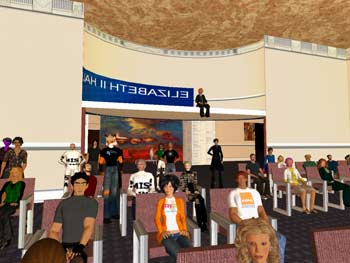This post is #5 in a series of 10 to celebrate the 10th anniversary of this blog while looking back at the past decade in higher ed digital marketing and communications.
Ever heard about the new shiny object syndrome (NSOS)?
If you’ve worked for a few years in marketing, communication, admissions or alumni relations at an institution, you have probably fallen for NSOS at least a few times.
I’ll come forward first and admit that I did a couple of times over the past 10 years.
When you work in a technology-driven area and your main target audiences are composed of high school seniors, college-aged students or young professionals, NSOS comes with the territory.
To use new technologies well, you have to experiment – or play with – them first. That’s part of the process of figuring out how innovations (aka things that didn’t exist before) are used by your target audiences in order to incorporate the new platform, practice or tool in your marketing and communication toolbox.
If you want to reach your target audience, you have to be where it is, right?
You wouldn’t take part in a college fair at a private high school for boys if you were working for the admissions office of a women’s college.
As a result, NSOS is a “work hasard” in our profession.
Remember how THIS was supposed to be the next big thing?
 When thinking about the biggest fads in higher education marketing over the past 10 years, SecondLife first comes to mind.
When thinking about the biggest fads in higher education marketing over the past 10 years, SecondLife first comes to mind.
SecondLife is a virtual world where you can live… a second life with avatars you design in environments you build (want to know more about it? check out the Wikipedia article)
For a reason I can’t understand yet, traditional and online media went crazy with it in 2006 and 2007.
SecondLife was supposed to change how we teach classes (and some experiments in this domain were quite successful), how we communicate and how we market our institutions.
I even attended some in-world education conferences and suggested institutions might want to participate to college fairs on SecondLife in one of the several posts I wrote about the platform.
The whole craze died pretty quickly among marketers (some high profile agencies and brands opened – and closed very fast -virtual offices in SecondLife). It stayed a bit longer in libraries and instructional design circles, because it was a platform that could be used for serious games – something that was already used in academic and research settings.
 Despite all the PR, SecondLife didn’t make it big. I blame its bloated application (it took forever to connect) and its lack of clear rules and purposes.
Despite all the PR, SecondLife didn’t make it big. I blame its bloated application (it took forever to connect) and its lack of clear rules and purposes.
When compared to World of Warcraft or Minecraft with today’s kids, it’s evident that SecondLife never took off to become the platform it wanted to be.
The main reason it didn’t work was the time commitment it required from its users to get ANY rewarding experience (with WoW rules and pay-offs are pretty clear).
Ease of use and simplicity enable fast adoption – and SecondLife was lacking on both fronts.
The fact that social media platforms were exploding at that time on the other end of the privacy and anonymity spectrum might have accelerated the demise of SecondLife.
Moreover, the chatter about SecondLife didn’t start in the hallways of high schools or college dorms, it was driven by adults.
Facebook, Twitter and Instagram
Started in a dorm room, Facebook’s popularity came from the bottom up. It wasn’t imposed or announced as being the ultimate communication platform, but was designed to meet the needs and demands of college life.
Launched only a few years after, Twitter kept lagging behind Facebook for a long time for college students — while picking up aficinados very quickly with higher ed professionals, techies and news junkies.
Yet, when it started reaching 20-25% among young adults, it reached a tipping point and got some steam.
Why did Twitter succeed? It was simple, fast, real-time and designed for mobile users who couldn’t type long updates or upload MBs of photos on their pricey data plan.
Instagram marked another step by tapping into the power of beautiful pictures with its amazing filters, the ubiquity of phone cameras, the decreasing data costs and the increasingly fast pace of life.
Facebook acquired Instagram for a good reason, the same reason it tried to buy SnapChat as well.
Today Facebook, Twitter, Instagram (and YouTube for different reasons and types of use) have become full-fledged communication and marketing platforms.
And, many new applications or platforms hope to replicate their success.
What about SnapChat or other messaging apps?
As I mentioned in my previous post, I’ve spent some time researching SnapChat for my next column to be published in the March 2015 issue of University Business.
Many higher ed bloggers and tech journalists started to write about SnapChat almost a year ago after a survey put it on their radar.
I didn’t add my voice to the SnapChat tune at that time, because it sounded a lot like a fad in the making (and I still remembered SecondLife ;-).
Was our industry getting ready for a new fad and was SnapChat the latest new shiny object?
A year ago, SnapChat still had the steamy reputation of being used by teenagers mainly for “safe sexting” – safe, because the shots would be automatically deleted once viewed by their recipient and any “screenshot action” would be reported to the sender.
 Yet, a few early adopters among institutions of higher education did what they are supposed to do and adopted the plaftorm last year, a decision supported by research reporting 77% of college students using the platform daily.
Yet, a few early adopters among institutions of higher education did what they are supposed to do and adopted the plaftorm last year, a decision supported by research reporting 77% of college students using the platform daily.
When I started asking questions on how these institutions use the platforms and what they do with it, I was pretty sure I would find a typical case of NSOS.
Yet, what I’ve heard listening to this totally non-representative sample of institutions has really puzzled me so far. There is a recurring theme that has nothing to do with what usually makes fads.
It is still early to say for sure, but I don’t think this one should go in the “Fads’ Bucket.” I revisited the topic after this this series about the past decade in higher ed marketing and communication.
I’ve published more of my research on SnapChat in higher ed to help you come to your own conclusions.




I asked students in my public relations class last week about SnapChat. Not only did about 25 of the 30 students say they use the service, but about 9 in 10 recommended that the university use it to reach students. I was particularly surprised by that second part.
Our school hasn’t used SnapChat for two reasons: I’ve doubted that the students wanted us there and I haven’t been sure that we have the time and energy to do it well. That first reason, at least, is getting harder to defend, though I’m not quite ready to say the case is closed. I look forward to your University Business piece.
New post: College Web Editor – Shiny objects, toys and fads in #highered and #hesm marketing http://t.co/jUmkvAGHFb
College Web Editor – Shiny objects, toys and fads in #highered and #hesm marketing: This post is #5 in a serie… http://t.co/FLsIMjNqio
What I’m reading right now from @karinejoly – it’s a good read! http://t.co/oyFOR2dIgC #10yearsCWE
Trying not to get caught up in the next shiny new object (toys or fad): Blog by @karinejoly http://t.co/DzXlxirI7g #hemktg
I asked students in my public relations class last week about SnapChat. Not only… http://t.co/Jq6QNLUfpC
Thanks for sharing the info, Matt! I will share some of the things I found before the piece gets out as well :-)
Shiny objects, toys and fads in #highered and #hesm marketing http://t.co/8f5L1VxAOQ
I want to go! “How to eat like Bond: European eateries where you can live & let dine” http://t.co/LyClkxEsPb via @mashable #geek